automobiles

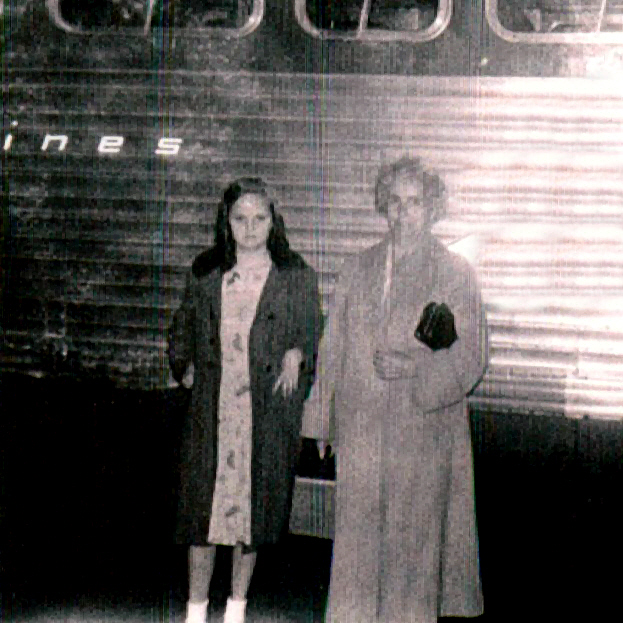 While visiting my Aunt Sandy Pattan during her stay at Elkhorn Valley Rehabilitation Hospital where she is recuperating from a recent surgery, we were talking about our favorite subject…the Byer-Pattan Family History. The subject turned to the many things her parents, my grandparents, George and Hattie Byer had seen come into being during their lifetimes. Grandpa was born on June 15, 1893, and Grandma was born on February 26, 1909. A sixteen-year age difference wasn’t that uncommon in those days, and many people to this day have a large age difference between husband and wife. Of course, the world when Grandma was born was already quite different than the world when Grandpa was born. The automobile was first invented…officially in 1889, but people really didn’t start owning them until about 1929, so by the time my grandparents were married in 1927, a few people might have owned their own car, but many still didn’t. For those, it was still the horse and buggy days.
While visiting my Aunt Sandy Pattan during her stay at Elkhorn Valley Rehabilitation Hospital where she is recuperating from a recent surgery, we were talking about our favorite subject…the Byer-Pattan Family History. The subject turned to the many things her parents, my grandparents, George and Hattie Byer had seen come into being during their lifetimes. Grandpa was born on June 15, 1893, and Grandma was born on February 26, 1909. A sixteen-year age difference wasn’t that uncommon in those days, and many people to this day have a large age difference between husband and wife. Of course, the world when Grandma was born was already quite different than the world when Grandpa was born. The automobile was first invented…officially in 1889, but people really didn’t start owning them until about 1929, so by the time my grandparents were married in 1927, a few people might have owned their own car, but many still didn’t. For those, it was still the horse and buggy days.
Planes were another thing that the most likely saw come into existence. While they existed at the time my grandmother was born, they did not during my grandfather’s early years. Nevertheless, like automobiles, planes were not something that was commonly in use for the average citizen. They were too expensive and so were only for the very rich or for military use. Most people who needed to travel long distances used the trains in those days, and some very likely still used the horse and buggy travel mode. Of course, truth be told, there 
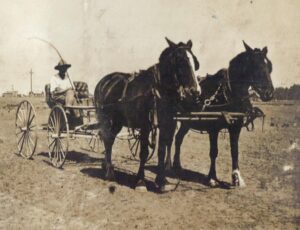 are still those who use a horse and buggy today. The Amish and even a few others, but the others are mostly for show, like parades, races, and such. Personally, my husband, Bob and I dearly love the trains. We ride one pretty much every year. I think trains are in my blood. My dad grew up riding them, because his dad worked as a carpenter for the Great Northers Railroad. Because of that, his kids got a free pass to ride…within reason, of course.
are still those who use a horse and buggy today. The Amish and even a few others, but the others are mostly for show, like parades, races, and such. Personally, my husband, Bob and I dearly love the trains. We ride one pretty much every year. I think trains are in my blood. My dad grew up riding them, because his dad worked as a carpenter for the Great Northers Railroad. Because of that, his kids got a free pass to ride…within reason, of course.
Televisions might have been “invented” in the late 1800s, but they were not common in homes until much later. In fact, in 1947 there were only a few thousand televisions in homes in the United States. I suppose that getting programming together could have had something to do with it, but many people thought it was an unnecessary evil, and maybe they had a point. Prior to that time, families would gather around the radio to hear the latest news…especially when it came to the important news of the wars.
Telephones were just as rare. Invented in 1869 by Alexander Graham Bell, although, it was truly a race between him and other competitors. Nevertheless, he was granted the patent. By 1920, about 35% of homes had phones. These days we couldn’t imagine running our lives without a phone, and who needs a home, we carry them in our purses, pockets, backpacks, and even on our wrist. If you don’t have access to your phone, it 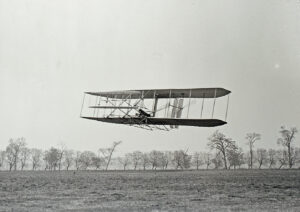
 is entirely your fault…either you forgot it or you let the battery die. Either way…your fault. Aunt Sandy and I agreed that there have also been a lot of changes in our eras, but maybe not quite as drastic as the ones our parents and grandparents saw. I’m quite sure there will be many more changes as time goes on. Space travel, for the common man being one. Wow!! Now, that’s something to think about!!
is entirely your fault…either you forgot it or you let the battery die. Either way…your fault. Aunt Sandy and I agreed that there have also been a lot of changes in our eras, but maybe not quite as drastic as the ones our parents and grandparents saw. I’m quite sure there will be many more changes as time goes on. Space travel, for the common man being one. Wow!! Now, that’s something to think about!!

 My husband’s grandmother, Vina Hein was a remarkable woman. I was quite impressed with her work ethic. That might seem a funny thing to say about a woman who no longer worked outside the home, but she was, nevertheless, dedicated to he work…her home. For most of her life, she lived as a pioneer woman, because while her home had many things, and was a normal stick built home, it did not have an indoor bathroom, even though the bathroom was somewhat completed. Water was the main concern, as well water was used, and there is always the concern of a well running dry, I suppose.
My husband’s grandmother, Vina Hein was a remarkable woman. I was quite impressed with her work ethic. That might seem a funny thing to say about a woman who no longer worked outside the home, but she was, nevertheless, dedicated to he work…her home. For most of her life, she lived as a pioneer woman, because while her home had many things, and was a normal stick built home, it did not have an indoor bathroom, even though the bathroom was somewhat completed. Water was the main concern, as well water was used, and there is always the concern of a well running dry, I suppose.
Grandma was born on Groundhog Day, February 2, 1909. Of course, we all know that the ground hog has a 50-50 chance of guessing right concerning winter, and I personally think that the latest Punxsutawney Phil, maybe doesn’t have its act together. Todays prediction was for an early spring, but…time will tell. According to statistics, the groundhog saw its shadow in 1909, so that should have been six more weeks of winter. I have no idea what the winter ended up like in Montana, but knowing what Montana winters are usually like, In would be surprised if the winter ended early.
Grandma Hein saw many changes over the years of her life. From the early days of automobiles and airplanes 
 to the more modern days of both before her passing. She saw telephones, and even the early days of cell phones. She was able to travel to the places where her children moved, and meet grandchildren, great grandchildren, and even 2nd great grandchildren. She lived a long and happy life, and yet we still never felt like she was with us long enough. Today, Grandma would have been 111 years old, but that would have been an unlikely birthday to have happened. Nevertheless, happy birthday in Heaven, Grandma Hein. We love and miss you very much.
to the more modern days of both before her passing. She saw telephones, and even the early days of cell phones. She was able to travel to the places where her children moved, and meet grandchildren, great grandchildren, and even 2nd great grandchildren. She lived a long and happy life, and yet we still never felt like she was with us long enough. Today, Grandma would have been 111 years old, but that would have been an unlikely birthday to have happened. Nevertheless, happy birthday in Heaven, Grandma Hein. We love and miss you very much.
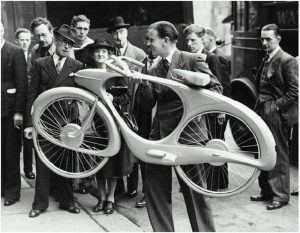
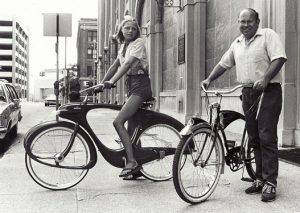 Today it would be worth about $4750. Would you pay that much for a bicycle? I don’t think I would, but then I don’t suppose I would be buying a bicycle called the Spacelander. Still, if I was, $4750 would be the asking price, or something close to that number. The Spacelander was created by Benjamin Bowden, who was born June 3, 1906. He was a British industrial designer, whose specialty was automobiles and bicycles. He received violin training at Guildhall, and completed a course in engineering at Regent. Bowden designed the coachwork of Healey’s Elliott, an influential British sports car.
Today it would be worth about $4750. Would you pay that much for a bicycle? I don’t think I would, but then I don’t suppose I would be buying a bicycle called the Spacelander. Still, if I was, $4750 would be the asking price, or something close to that number. The Spacelander was created by Benjamin Bowden, who was born June 3, 1906. He was a British industrial designer, whose specialty was automobiles and bicycles. He received violin training at Guildhall, and completed a course in engineering at Regent. Bowden designed the coachwork of Healey’s Elliott, an influential British sports car.
In 1925 Bowden began working as an automobile designer for the Rootes Group. By the late 1930s, Bowden was the chief body engineer for the Humber car factory in Coventry. During World War II, his design of an armored car was used by Winston Churchill and George VI for their protection. In 1945, he left the Rootes Group, and with partner John Allen, formed his own design company in Leamington Spa. The studio was one of the first such design firms in Britain. Bowden designed the body of Healey’s Elliott in 1947. It was the first British car to break the 100 mile per hour barrier. Working with Achille Sampietro who created the chassis, Bowden drew the initial design for the auto directly onto the walls of his house. Unusual…yes, but it worked for him, I guess. Shortly before his departure to the United States Bowden penned a sketch design for a two-seater sports racing prototype, the Zethrin Rennsport, being developed by Val Zethrin. This used the same wheelbase as the short-chassis Squire Sports, and was dressed in a contemporary, streamlined body. This design theme was carried through to his future work on the early Chevrolet Corvette and Ford Thunderbird.
He went on to design the Spacelander in 1946. It was a space-age looking bicycle, that was ahead of its time, since space travel wouldn’t occur for two decades. It’s not that the Spacelander would ever be used in space, but rather the design that seemed space-like. Bowden called the bicycle the Classic. In the early or mid 1950s, Bowden moved to Michigan, in the United States. While in Muskegon, Michigan in 1959, he met with Joe Kaskie, of the George Morrell Corporation, a custom molding company. Kaskie suggested molding the bicycle in fiberglass instead of aluminum, but the fiberglass frame was relatively fragile, and its unusual nature made it difficult to market to established bicycle distributors. Although he retained the futuristic appearance of the Classic, Bowden abandoned the hub dynamo, and replaced the drive-train with a more common sprocket-chain assembly. The new name, Spacelander, was chosen to capitalize on interest in the Space Race. Financial 
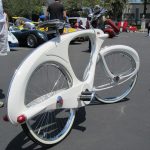 troubles from the distributor forced Bowden to rush development of the Spacelander, which was released in 1960 in five colors: Charcoal Black, Cliffs of Dover White, Meadow Green, Outer Space Blue, and Stop Sign Red. The bicycle was priced at $89.50, which made it one of the more expensive bicycles on the market. Only 522 Spacelander bicycles were shipped before production was stopped, although more complete sets of parts were manufactured. In more recent years, the Spacelander has become a collector’s item…hence the price tag.
troubles from the distributor forced Bowden to rush development of the Spacelander, which was released in 1960 in five colors: Charcoal Black, Cliffs of Dover White, Meadow Green, Outer Space Blue, and Stop Sign Red. The bicycle was priced at $89.50, which made it one of the more expensive bicycles on the market. Only 522 Spacelander bicycles were shipped before production was stopped, although more complete sets of parts were manufactured. In more recent years, the Spacelander has become a collector’s item…hence the price tag.
 As automobiles became commonplace…or at least more so than they had been, people began to realize that there needed to be some controls on their usage…specially in the area of speed. Most people know that is a car or other vehicle can go fast, there will always be someone out there, who wants to push the envelope and see just how fast it will go, throwing caution to the wind. With increased speeds would also follow, increased numbers of accidents. There would need to be some rules to follow.
As automobiles became commonplace…or at least more so than they had been, people began to realize that there needed to be some controls on their usage…specially in the area of speed. Most people know that is a car or other vehicle can go fast, there will always be someone out there, who wants to push the envelope and see just how fast it will go, throwing caution to the wind. With increased speeds would also follow, increased numbers of accidents. There would need to be some rules to follow.
There were already speed limits in the United States for non-motorized vehicles. In 1652, the colony of New Amsterdam, which is now New York, issued a decree stating that “[N]o wagons, carts or sleighs shall be run, rode or driven at a gallop” at the risk of incurring a fine starting at “two pounds Flemish,” or about $150 in today’s currency. In 1899, the New York City cabdriver Jacob German was arrested for driving his electric taxi at 12 miles per hour, but did the prior law really apply electric cars? It was becoming more and more obvious that some sort of legislation was necessary to ensure the safety of those operating these new machines, and those around them. So began the path to Connecticut’s 1901 speed limit legislation. Representative Robert Woodruff submitted a  bill to the State General Assembly proposing a motor-vehicles speed limit of 8 miles per hour within city limits and 12 miles per hour outside. While the law passed in May of 1901 specified higher speed limits, it required drivers to slow down upon approaching or passing horse-drawn vehicles, and come to a complete stop if necessary to avoid scaring the animals. I can’t imagine some of the restrictions listed there, because people would be stopped more than they were driving, but you have to start somewhere, and Connecticut was that starting point, when, on May 21, 1901 it became the first state to pass a law regulating motor vehicles, limiting their speed to 12 miles per hour in cities and 15 miles per hour on country roads.
bill to the State General Assembly proposing a motor-vehicles speed limit of 8 miles per hour within city limits and 12 miles per hour outside. While the law passed in May of 1901 specified higher speed limits, it required drivers to slow down upon approaching or passing horse-drawn vehicles, and come to a complete stop if necessary to avoid scaring the animals. I can’t imagine some of the restrictions listed there, because people would be stopped more than they were driving, but you have to start somewhere, and Connecticut was that starting point, when, on May 21, 1901 it became the first state to pass a law regulating motor vehicles, limiting their speed to 12 miles per hour in cities and 15 miles per hour on country roads.
Immediately following this landmark legislation, New York City went to work to keep up, and introduced the world’s first comprehensive traffic code in 1903. Adoption of speed regulations and other traffic codes was a slow and uneven process across the nation, however. As late as 1930, a dozen states had no speed limit, while 28 states did not even require a driver’s license to operate a motor vehicle. Rising fuel prices contributed to the lowering of speed limits in several states in the early 1970s, and in January 1974 President Richard Nixon 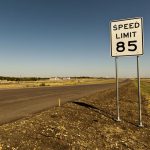 signed a national speed limit of 55 miles per hour into law. These measures led to a welcome reduction in the nation’s traffic fatality rate, which dropped from 4.28 per million miles of travel in 1972 to 3.33 in 1974 and a low of 2.73 in 1983.
signed a national speed limit of 55 miles per hour into law. These measures led to a welcome reduction in the nation’s traffic fatality rate, which dropped from 4.28 per million miles of travel in 1972 to 3.33 in 1974 and a low of 2.73 in 1983.
Concerns about fuel availability and cost later subsided, and in 1987 Congress allowed states to increase speed limits on rural interstates to 65 mph. The National Highway System Designation Act of 1995 repealed the maximum speed limit. This returned control of setting speed limits to the states, many of which soon raised the limits to 70 mph and higher on a portion of their roads, including rural and urban interstates and limited access roads.

 Prior to 1956, the road and highway system in the United States, well…lets just say, it left something to be desired…like passable roads for instance. Yes, there were a few highways, but on June 29, 1956, President Dwight Eisenhower signed the Federal-Aid Highway Act of 1956. This bill changed the highways by creating a 41,000-mile “National System of Interstate and Defense Highways” that would, according to Eisenhower, eliminate unsafe roads, inefficient routes, traffic jams and all of the other things that got in the way of “speedy, safe transcontinental travel.” At the same time, highway advocates argued, “in case of atomic attack on our key cities, the road net [would] permit quick evacuation of target areas.” The 1956 law, which allocated more than $30 billion for the construction, declared that the construction of an elaborate expressway system was “essential to the national interest.” The plan included a lot of discussion on things like where exactly the highways should be built, and how much of the cost should be carried by the federal government versus the individual states. Several competing bills went through Congress before 1956, like the ones spearheaded by the retired general and engineer Lucius D Clay, Senator Albert Gore Sr, and Representative George H Fallon, who called his program the “National System of Interstate and Defense Highways,” thereby linking the nationwide construction of highways with the preservation of a strong national defense.
Prior to 1956, the road and highway system in the United States, well…lets just say, it left something to be desired…like passable roads for instance. Yes, there were a few highways, but on June 29, 1956, President Dwight Eisenhower signed the Federal-Aid Highway Act of 1956. This bill changed the highways by creating a 41,000-mile “National System of Interstate and Defense Highways” that would, according to Eisenhower, eliminate unsafe roads, inefficient routes, traffic jams and all of the other things that got in the way of “speedy, safe transcontinental travel.” At the same time, highway advocates argued, “in case of atomic attack on our key cities, the road net [would] permit quick evacuation of target areas.” The 1956 law, which allocated more than $30 billion for the construction, declared that the construction of an elaborate expressway system was “essential to the national interest.” The plan included a lot of discussion on things like where exactly the highways should be built, and how much of the cost should be carried by the federal government versus the individual states. Several competing bills went through Congress before 1956, like the ones spearheaded by the retired general and engineer Lucius D Clay, Senator Albert Gore Sr, and Representative George H Fallon, who called his program the “National System of Interstate and Defense Highways,” thereby linking the nationwide construction of highways with the preservation of a strong national defense.
For President Eisenhower, however, who had participated in the United States Army’s first transcontinental motor convoy in 1919, during World War II, there was a realization that the country needed a better highway system. He had seen Germany’s Autobahn network, and admired the efficiency of it. In January 1956, Eisenhower repeated his 1954 State of the Union address call for a “modern, interstate highway system.” Later that month, Fallon introduced a revised version of his bill as the Federal Highway Act of 1956. It provided for a 41,000 mile national system of interstate and defense highways to be built over 13 years, with the federal government paying for 90 percent, or $24.8 billion. To raise funds for the project, Congress increased the gas tax from two to three cents per gallon and impose a series of other highway user tax changes. On June 26, 1956, the Senate approved the final version of the bill by a vote of 89 to 1. Senator Russell Long, who opposed the gas tax increase, cast the single “no” vote. That same day, the House approved the bill by a voice vote, and three days later, Eisenhower signed it into law.
The highway construction began almost immediately. With the construction came the employment of tens of thousands of workers and the use of billions of tons of gravel and asphalt. The system fueled a surge in the interstate trucking industry. That was good, but soon it pushed aside the railroads to gain the lion’s share of the domestic shipping market. Interstate highway construction also fostered the growth of roadside businesses such as restaurants, most of which were fast-food chains, hotels and amusement parks. By the 1960s, an estimated one in seven Americans was employed directly or indirectly by the automobile industry. Not only 
 that, but America had become a nation of drivers. Legislation has extended the Interstate Highway Revenue Act three times. Many historians say it is Eisenhower’s greatest domestic achievement. Many called the years between 1956 and 1966 “the Greatest Decade.” Still, critics of the system have pointed to its less positive effects, including the loss of productive farmland and the demise of small businesses and towns in more isolated parts of the country. I suppose that’s true, but it was inevitable.
that, but America had become a nation of drivers. Legislation has extended the Interstate Highway Revenue Act three times. Many historians say it is Eisenhower’s greatest domestic achievement. Many called the years between 1956 and 1966 “the Greatest Decade.” Still, critics of the system have pointed to its less positive effects, including the loss of productive farmland and the demise of small businesses and towns in more isolated parts of the country. I suppose that’s true, but it was inevitable.
 I have often wondered what it must have been like when the first automobiles were starting to make their way onto the scene. I think that both the people and the horses, or other animals used to pull wagons, must have just about freaked out. People had no idea that such things were possible back then. And the horses…well, after the noise scared the daylights out of them, they probably took off like rockets…maybe inspiring future inventions.
I have often wondered what it must have been like when the first automobiles were starting to make their way onto the scene. I think that both the people and the horses, or other animals used to pull wagons, must have just about freaked out. People had no idea that such things were possible back then. And the horses…well, after the noise scared the daylights out of them, they probably took off like rockets…maybe inspiring future inventions.
I think that the first thought on peoples’ minds would be to distrust this new fangled contraption. They would wonder if it was going to run away like horses sometimes did, only there would be no reasoning with it or pulling on the reigns to stop it. Or, would it blow up…after all, it was a machine. Or, could it be dangerous…going out of control or rolling over. Maybe they thought all these things, but it’s quite possible that they simply thought that this new fangled machine was an unnecessary luxury…a waste of money…or maybe just for the rich people, who always seemed to be too extravagant anyway. People were used to being conservative with their supplies and their money.
Change is often a difficult thing to accept, and I can imagine that people like my great grandparents were pretty unsure of some of the new inventions that were showing up. They were used to their old ways, and it just seemed very extravigant to buy into these new things. Yes, change is hard to accept, but once we get used to it, many inventions turn out to be not only good things, but in many ways, such as with the automobile, they are destined to become something so necessary to life in this world, that it would be difficult to live without them.
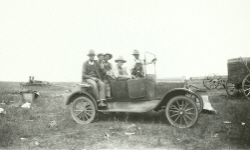
I like to think that my grandparents were among those who accepted change easily. I see them as people who had open minds, and who saw change for what it was…necessary. I like to think of them as the kind of people who wanted to be living in the present, with all it had to offer. Still, I have to wonder what they might think of some of the new fangled contraptions we have today, such as the cell phone, lap top, Kindle, iPhone, and iPad. If you suddenly put those things into the mid-1800’s…wouldn’t that just blow your mind.

